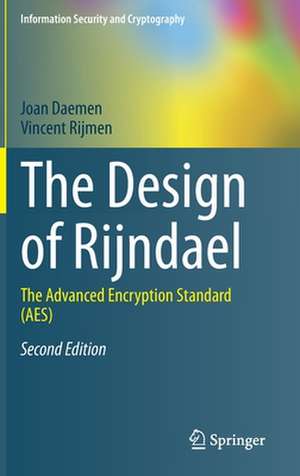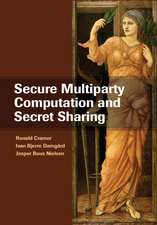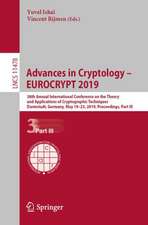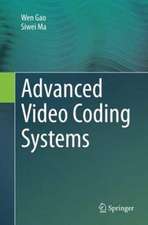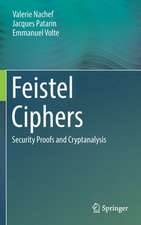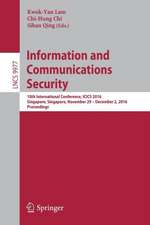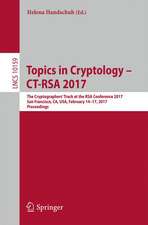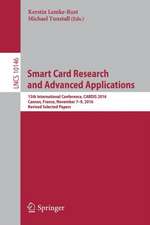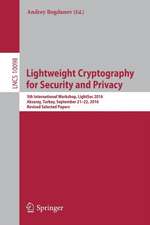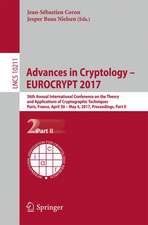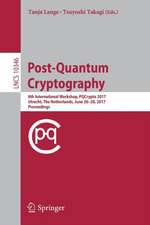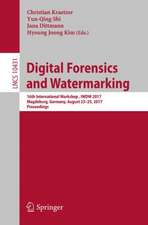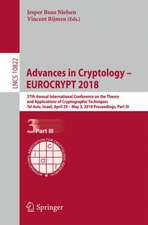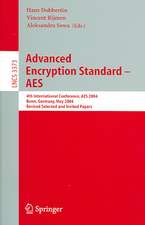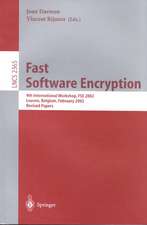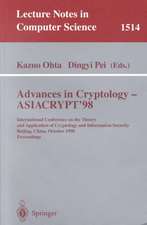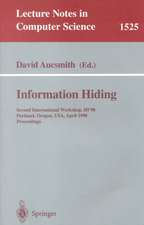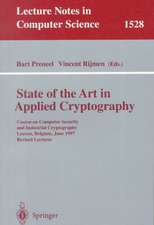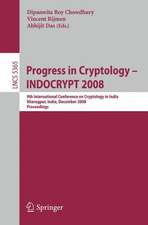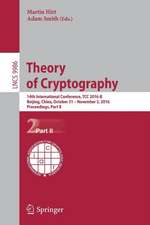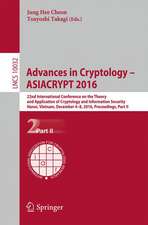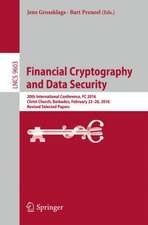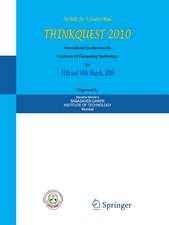The Design of Rijndael: The Advanced Encryption Standard (AES): Information Security and Cryptography
Autor Joan Daemen, Vincent Rijmenen Limba Engleză Hardback – 24 mai 2020
The authors developed the Rijndael algorithm and in this book they explain the AES selection process and their motivation in the light of the earlier Data Encryption Standard. They explain their design philosophy and implementation and optimization aspects, and the strength of their approach against cryptanalysis. They support the text with the relevant mathematics, reference code, and test vectors.
In this new edition the authors updated content throughout, added new chapters, and adapted their text to the new terminology in use since the first edition. This is a valuable reference for all professionals, researchers, and graduate students engaged with data encryption.
| Toate formatele și edițiile | Preț | Express |
|---|---|---|
| Paperback (2) | 495.03 lei 38-44 zile | |
| Springer Berlin, Heidelberg – 11 dec 2011 | 495.03 lei 38-44 zile | |
| Springer Berlin, Heidelberg – 24 mai 2021 | 999.27 lei 6-8 săpt. | |
| Hardback (2) | 591.34 lei 6-8 săpt. | |
| Springer Berlin, Heidelberg – 14 feb 2002 | 591.34 lei 6-8 săpt. | |
| Springer Berlin, Heidelberg – 24 mai 2020 | 795.27 lei 38-44 zile |
Din seria Information Security and Cryptography
- 20%
 Preț: 352.02 lei
Preț: 352.02 lei - 20%
 Preț: 770.31 lei
Preț: 770.31 lei - 20%
 Preț: 303.85 lei
Preț: 303.85 lei - 20%
 Preț: 1452.94 lei
Preț: 1452.94 lei - 20%
 Preț: 988.49 lei
Preț: 988.49 lei - 20%
 Preț: 327.10 lei
Preț: 327.10 lei - 20%
 Preț: 636.41 lei
Preț: 636.41 lei - 20%
 Preț: 453.21 lei
Preț: 453.21 lei - 20%
 Preț: 607.34 lei
Preț: 607.34 lei - 20%
 Preț: 331.40 lei
Preț: 331.40 lei - 20%
 Preț: 406.32 lei
Preț: 406.32 lei - 20%
 Preț: 346.56 lei
Preț: 346.56 lei - 18%
 Preț: 950.52 lei
Preț: 950.52 lei - 20%
 Preț: 595.08 lei
Preț: 595.08 lei - 20%
 Preț: 487.74 lei
Preț: 487.74 lei -
 Preț: 450.28 lei
Preț: 450.28 lei - 20%
 Preț: 877.79 lei
Preț: 877.79 lei - 20%
 Preț: 332.39 lei
Preț: 332.39 lei - 20%
 Preț: 418.59 lei
Preț: 418.59 lei - 20%
 Preț: 649.28 lei
Preț: 649.28 lei - 20%
 Preț: 552.73 lei
Preț: 552.73 lei - 20%
 Preț: 577.41 lei
Preț: 577.41 lei - 20%
 Preț: 653.38 lei
Preț: 653.38 lei - 20%
 Preț: 670.26 lei
Preț: 670.26 lei - 20%
 Preț: 334.53 lei
Preț: 334.53 lei - 20%
 Preț: 414.72 lei
Preț: 414.72 lei - 20%
 Preț: 640.69 lei
Preț: 640.69 lei
Preț: 795.27 lei
Preț vechi: 1046.41 lei
-24% Nou
Puncte Express: 1193
Preț estimativ în valută:
152.19€ • 165.26$ • 127.84£
152.19€ • 165.26$ • 127.84£
Carte tipărită la comandă
Livrare economică 18-24 aprilie
Preluare comenzi: 021 569.72.76
Specificații
ISBN-13: 9783662607688
ISBN-10: 3662607689
Pagini: 282
Ilustrații: XVIII, 282 p. 49 illus.
Dimensiuni: 155 x 235 mm
Greutate: 0.6 kg
Ediția:2nd ed. 2020
Editura: Springer Berlin, Heidelberg
Colecția Springer
Seria Information Security and Cryptography
Locul publicării:Berlin, Heidelberg, Germany
ISBN-10: 3662607689
Pagini: 282
Ilustrații: XVIII, 282 p. 49 illus.
Dimensiuni: 155 x 235 mm
Greutate: 0.6 kg
Ediția:2nd ed. 2020
Editura: Springer Berlin, Heidelberg
Colecția Springer
Seria Information Security and Cryptography
Locul publicării:Berlin, Heidelberg, Germany
Cuprins
The Advanced Encryption Standard Process.- Preliminaries.- Specification of Rijndael.- Implementation Aspects.- Design Philosophy.- The Data Encryption Standard.- Correlation Matrices.- Difference Propagation.- The Wide Trail Strategy.- Cryptanalysis.- The Road to Rijndael.- Correlation Analysis in GF(2n).- On the EDP of Two- and Four-Round Differentials and the ELP of Two- and Four-Round Hulls.- Two-Round Differential Trail Clustering.- Plateau Trails.- App. A, Substitution Tables.- App. B, Test Vectors.- App. C, Reference Code.- Bibliography.- Index.
Recenzii
“I enjoyed reading this book, which is now sitting on my new office bookshelves, as it brought back memories of the late 1990 and early 2000s crypto waiting game, going from round to round in the NIST competition.” (Sven Dietrich, Cipher, ieee-security.org, March 21, 2021)
Notă biografică
After graduating in electromechanical engineering Joan Daemen was awarded his PhD in 1995 from KU Leuven. After his contract ended at COSIC, he privately continued his crypto research and contacted Vincent Rijmen to continue their collaboration that would lead to the Rijndael block cipher, and this was selected by NIST as the new Advanced Encryption Standard in 2000. After over 20 years of security industry experience, including work as a security architect and cryptographer for STMicroelectronics, he is now a professor in the Digital Security Group at Radboud University Nijmegen. He codesigned the Keccak cryptographic hash which was selected as the SHA-3 hash standard by NIST in 2012 and is one of the founders of the permutation-based cryptography movement. In 2017 he won the Levchin Prize for Real World Cryptography "for the development of AES and SHA3". In 2018 he was awarded an ERC advanced grant for research on the foundations of security in symmetric cryptography.
After graduating in electronics engineering, Vincent Rijmen was awarded his PhD in 1997 from KU Leuven. Researching there in the ESAT/COSIC lab he developed the Rijndael algorithm with Joan Daemen, and this was selected by NIST as the new Advanced Encryption Standard in 2000. After work in the security industry, as chief cryptographer at Cryptomathic, he was first a professor at Technische Universität Graz and now in the COSIC Lab in Leuven. He is also an adjunct professor at the Selmer Center (University of Bergen). In 2019, he was named a Fellow of the International Association for Cryptologic Research for "co-designing AES, contributions to the design and cryptanalysis of symmetric primitives, and service to the IACR". His research interests include symmetric cryptography and cryptanalysis, side-channel attacks, and mathematical theories for the design of symmetric cryptography primitives.
After graduating in electronics engineering, Vincent Rijmen was awarded his PhD in 1997 from KU Leuven. Researching there in the ESAT/COSIC lab he developed the Rijndael algorithm with Joan Daemen, and this was selected by NIST as the new Advanced Encryption Standard in 2000. After work in the security industry, as chief cryptographer at Cryptomathic, he was first a professor at Technische Universität Graz and now in the COSIC Lab in Leuven. He is also an adjunct professor at the Selmer Center (University of Bergen). In 2019, he was named a Fellow of the International Association for Cryptologic Research for "co-designing AES, contributions to the design and cryptanalysis of symmetric primitives, and service to the IACR". His research interests include symmetric cryptography and cryptanalysis, side-channel attacks, and mathematical theories for the design of symmetric cryptography primitives.
Textul de pe ultima copertă
This is the authoritative guide to Rijndael, the block cipher whose elegance, efficiency, security, and principled design made it the Advanced Encryption Standard (AES), now the most widely applied data encryption technology.
The authors developed the Rijndael algorithm and in this book they explain the AES selection process and their motivation in the light of the earlier Data Encryption Standard. They explain their design philosophy and implementation and optimization aspects, and the strength of their approach against cryptanalysis. They support the text with the relevant mathematics, reference code, and test vectors.
In this new edition the authors updated content throughout, added new chapters, and adapted their text to the new terminology in use since the first edition. This is a valuable reference for all professionals, researchers, and graduate students engaged with data encryption.
The authors developed the Rijndael algorithm and in this book they explain the AES selection process and their motivation in the light of the earlier Data Encryption Standard. They explain their design philosophy and implementation and optimization aspects, and the strength of their approach against cryptanalysis. They support the text with the relevant mathematics, reference code, and test vectors.
In this new edition the authors updated content throughout, added new chapters, and adapted their text to the new terminology in use since the first edition. This is a valuable reference for all professionals, researchers, and graduate students engaged with data encryption.
Caracteristici
In 2000 the US National Institute of Standards and Technology selected the block cipher Rijndael as the Advanced Encryption Standard (AES), replacing the Data Encryption Standard (DES) as the most widely applied data encryption technology In this new edition the authors updated content throughout, added new chapters, and adapted their text to the new terminology in use since the first edition This is a valuable reference for all professionals, researchers, and graduate students engaged with data encryption
Descriere
Descriere de la o altă ediție sau format:
Rijndael was the surprise winner of the contest for the new Advanced En cryption Standard (AES) for the United States. This contest was organized and run by the National Institute for Standards and Technology (NIST) be ginning in January 1997; Rijndael was announced as the winner in October 2000. It was the "surprise winner" because many observers (and even some participants) expressed scepticism that the D.S. government would adopt as an encryption standard any algorithm that was not designed by D.S. citizens. Yet NIST ran an open, international, selection process that should serve as model for other standards organizations. For example, NIST held their 1999 AES meeting in Rome, Italy. The five finalist algorithms were designed by teams from all over the world. In the end, the elegance, efficiency, security, and principled design of Rijndael won the day for its two Belgian designers, Joan Daemen and Vincent Rijmen, over the competing finalist designs from RSA, IBM, Counterpane Systems, and an EnglishjIsraelijDanish team. This book is the story of the design of Rijndael, as told by the designers themselves. It outlines the foundations of Rijndael in relation to the previous ciphers the authors have designed. It explains the mathematics needed to and the operation of Rijndael, and it provides reference C code and underst test vectors for the cipher.
Rijndael was the surprise winner of the contest for the new Advanced En cryption Standard (AES) for the United States. This contest was organized and run by the National Institute for Standards and Technology (NIST) be ginning in January 1997; Rijndael was announced as the winner in October 2000. It was the "surprise winner" because many observers (and even some participants) expressed scepticism that the D.S. government would adopt as an encryption standard any algorithm that was not designed by D.S. citizens. Yet NIST ran an open, international, selection process that should serve as model for other standards organizations. For example, NIST held their 1999 AES meeting in Rome, Italy. The five finalist algorithms were designed by teams from all over the world. In the end, the elegance, efficiency, security, and principled design of Rijndael won the day for its two Belgian designers, Joan Daemen and Vincent Rijmen, over the competing finalist designs from RSA, IBM, Counterpane Systems, and an EnglishjIsraelijDanish team. This book is the story of the design of Rijndael, as told by the designers themselves. It outlines the foundations of Rijndael in relation to the previous ciphers the authors have designed. It explains the mathematics needed to and the operation of Rijndael, and it provides reference C code and underst test vectors for the cipher.
